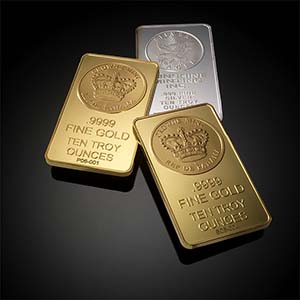Precious metals investors are always fixated on the gold-to-silver ratio.
That’s because the gold-to-silver ratio helps determine when to buy and sell the shiny metals. The ratio should be on the radar of every precious metal investor, from the novice to the sophisticated.
So, what is the gold-to-silver ratio?
Simply put, the gold-to-silver ratio is the amount of silver it takes to purchase one ounce of gold.
 A number of websites, including Kitco, provide the current ratio. But it’s easy enough to calculate on your own.
A number of websites, including Kitco, provide the current ratio. But it’s easy enough to calculate on your own.
Simply take the present price of gold and divide it by the current price of silver. The figure you get is the gold-to-silver ratio.
For example, using recent prices: $1,097 (gold price per ounce) divided by $14.63 (silver price per ounce) equals approximately 75. That’s today’s gold-to-silver ratio.
That means at current prices, it would take 75 ounces of silver to buy one ounce of gold.
Now that you know what the gold-to-silver ratio is and how to find it, here’s why it’s so important to investors…
How to Use the Gold-To-Silver Ratio
The gold-to-silver ratio can be used as a signal for when to buy and sell the yellow and white metals.
When the ratio is high, the general consensus is that silver is in favor. That’s because, relative to the ratio, silver is cheap.
On the other hand, a low ratio tends to favor gold and may be a sign it’s a good time to buy the yellow metal. Many “smart money” traders are apt to sell silver for gold as the ratio declines.
Since 1687, as far back as records reach, the gold-to-silver ratio has fluctuated between roughly 14 and 100.
Prior to 1900, the ratio remained relatively stable and lingered around 16. The reason for muted movement was that many countries, including the United States, used gold- and silver-backed currencies and placed legal limits on the ratio. In August 1971, however, the United States took the dollar off the gold standard, and the ratio grew more volatile.
Since 1900, the gold-to-silver ratio has averaged about 47 to 50. Still, it has swung widely at times…
As gold and silver prices surged in January 1980, the ratio dipped to as low as 17. At the time, gold surged from $559.50 an ounce to $850 an ounce. The silver price also skyrocketed from $11 an ounce to $49.45 an ounce.
Over the next three decades, the ratio rose as precious metal prices slipped.
“When the financial crisis hit in late 2008, gold dropped to $720, but silver fell harder to $9,” Money Morning Resource Specialist Peter Krauth said. “This caused the gold-to-silver ratio to spike to 80. Gold clearly acted as the safe haven in that time of duress.”
By 2014 average prices, the gold-to-silver ratio had settled back down around 66.
Here’s what precious metal investors can expect for the ratio for the rest of 2015…
What’s Next for Gold-to-Silver Ratio?
One of today’s great debates among precious metal bulls and bears is where the ratio is headed.
“Odds are it's topping out, or about to soon,” Krauth said in April. “That means the gold-to-silver ratio will likely revert to its longer-term average and start trending back down.”
Since the precious metals bull market began in 2001, the gold-to-silver ratio has averaged about 55. After topping around 77 late last year, the ratio has been gradually declining.
“As the gold-to-silver ratio declines, silver's price is rising relative to gold's,” Krauth continued. “I expect we'll continue to see a reversion to the mean of around 55 for the gold-to-silver ratio.”
While silver might not have formed an absolute bottom yet, all indications are that silver markets are presently much closer to a bottom than a top.
“Anyone who doesn't own silver should be looking to buy gradually and build up their position through dollar-cost averaging over the next six to 12 months,” Krauth said.
Here is the full story on why silver prices will continue to climb throughout the rest of 2015…
Follow us on Twitter @moneymorning.
Like us on Facebook: Money Morning.
Related Articles:
- The Silver Institute: Silver Price History
- Kitco: Precious Metal Prices
- GoldPrice.org: Gold Silver Ratio


